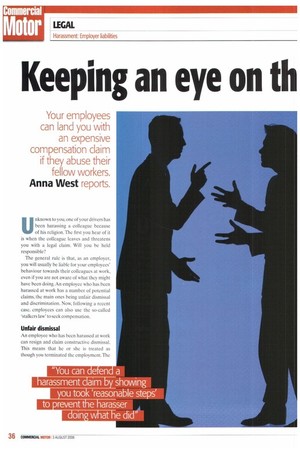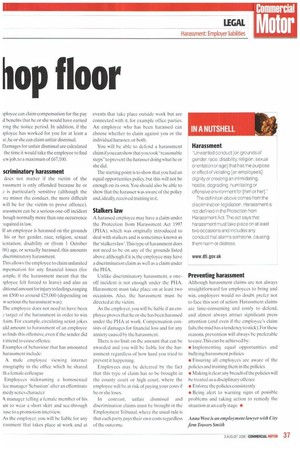Keeping an eye o th flop floor
Page 36

Page 37

If you've noticed an error in this article please click here to report it so we can fix it.
Your employees can land you with an expensive compensation claim if they abuse their fellow workers.
Anna West reports.
Unknown to you. one of your drivers has been harassing a colleague because of his religion. The first you hear of it is when the colleague leaves and threatens you with a legal claim. Will you be held responsible?
The general rule is that, as an employer, you will usually be liable for your employees' behaviour towards their colleagues at work, even if you are not aware of what they might have been doing. An employee who has been harassed at work has a number of potential claims, the main ones being unfair dismissal and discrimination. Now, following a recent case, employees can also use the so-called 'stalkers law' to seek compensation.
Unfair dismissal
An employee who has been harassed at work can resign and claim constructive dismissal. This means that he or she is treated as though you terminated the employment.The iployee can claim compensation for the pay d benefits that he or she would have earned ring the notice period. In addition. if the iployee has worked for you for at least a ar, he or she can claim unfair dismissal. Damages for unfair dismissal are calculated the time it would take the employee to find Levy job, to a maximum of £67,100.
scriminatory harassment
does not matter if the victim of the rassment is only offended because he or e is particularly sensitive (although the )re minor the conduct, the more difficult will be for the victim to prove offence). irassment can be a serious one-off incident hough normally more than one occurrence -equired in law.
[f an employee is harassed on the grounds his or her gender, race, religion, sexual ientation, disability or (from 1 October 06) age, or sexually harassed, this amounts discriminatory harassment.
This allows the employee to claim unlimited mpensation for any financial losses (for ample, if the harassment meant that the iployee felt forced to leave) and also an di Li onal am ountfor injury to feefings,ranging )m £500 to around £25,000 (depending on w serious the harassment was).
The employee does not need to have been target of the harassment in order to win For example, circulating sexist jokes uld amount to harassment of an employee io finds this offensive, even if the sender did intend to cause offence.
Examples of behaviour that has amounted harassment include: A male employee viewing internet ,rnography in the office which he shared th a female colleague Employees nicknaming a homosexual [lee manager 'Sebastian' after an effeminate medy series character k manager telling a female member of his sm to wear a short skirt and see-through iuse to a promotion interview.
As the employer, you will be liable for any rassment that takes place at work and at events that take place outside work but are connected with it, for example office parties. An employee who has been harassed can choose whether to claim against you or the individual harasser, or both.
You will be able to defend a harassment claim if you can show that you took -reasonable steps" toprevent the harasser doing what he or she did.
The starting point is to show that you had an equal opportunities policy, but this will not be enough on its own. You should also be able to show that the harasser was aware of the policy and, ideally, received training in it.
Stalkers law
A harassed employee may have a claim under the Protection from Harassment Act 1997 (PHA). which was originally introduced to deal with stalkers and is sometimes known as the 'stalkers law',This type of harassment does not need to be on any of the grounds listed above, although if it is, the employee may have a discrimination claim as well as a claim under the PHA.
Unlike discriminatory harassment, a oneoff incident is not enough under the PHA. Harassment must take place on at least two occasions. Also, the harassment must be directed at the victim.
As the employer, you will he liable if an employee proves that he or she has been harassed under the PHA at work. Compensation consists of damages for financial loss and for any anxiety caused by the harassment.
There is no limit on the amount that can be awarded and you will be liable for the harassment regardless of how hard you tried to prevent it happening.
Employees may be deterred by the fact that this type of claim has to be brought in the county court or high court, where the employee will be at risk of paying your costs if he or she loses.
In contrast, unfair dismissal and discrimination claims must be brought in the Employment Tribunal. where the usual rule is that each party pays their own costs regardless of the outcome.
Preventing harassment
Although harassment claims are not always straightforward for employees to bring and win, employers would no doubt prefer not to face this sort of action. Harassment claims are time-consuming and costl■,, to defend, and almost always attract significant press attention (and even if the employee's claim fails, the mud has a tendency to stick). For these reasons, prevention will always be preferable to cure.This can be achieved by: • Implementing equal opportunities and bullying/harassment policies • Ensuring all employees are aware of the policies and training them in the policies • Making it clear any breach of the policies will he treated as a disciplinary offence • Enforce the policies consistently • Being alert to warning signs of possible problems and taking action to remedy the situation at an early stage. •




























































































































































































